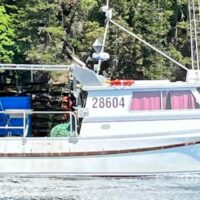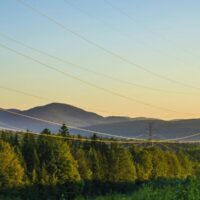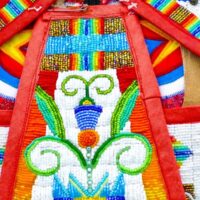The Anishnabe Moose Committee (AMC) is a grassroots collective of people from several Anishnabe (Algonquin) communities working directly with our communities to protect the moose, land, and culture. The authors of this case study are Shannon, the coordinator of the AMC, and Jaimie, the Land Studies coordinator for the AMC. We are writing this case study as individuals representing perspectives from the AMC and Anishnabe knowledge.
Rooted in traditional governance, AMC prioritizes community-led decision-making, knowledge-sharing, and land-based education. AMC’s work began in response to the alarming decline of moose populations in La Vérendrye Wildlife Reserve. However, Elders emphasized that moose decline is an issue that must be addressed as a nation. These efforts quickly expanded to all Anishnabe communities across the Ottawa River watershed—our traditional territory.
Throughout 2022, we held community workshops in nine Anishnabe communities, gathering insights from Elders, hunters, and land users. This work culminated in a preliminary report released in 2022 (available here). Climate change, forestry, and over-hunting were identified as the main drivers of moose decline in and around La Vérendrye Wildlife Reserve. Community-driven solutions were also proposed to revitalize the moose population. Since then, the AMC has continued working with communities and Elders to follow through on the recommendations that come directly from communities.
[Click to see in English] Wedi ojabigin Moz Anike-Niganiziwog kagi-ojibegawatcj eja nisistimatcj Aki Inakonigewin kija kipwa-nag kina moazag.
This case study provides an overview of policy lessons learned from the AMC’s work and recommendations for advancing climate policy that protects the moose both within and beyond the Ottawa River watershed.
Mozag kijenenimanan, tedago nogom tija nanegadjitog | Moose are our relatives, and they are in trouble
Moose have taken care of Anishnabeg since time immemorial. They have kept us alive, providing healthy food, shelter, mukluks, baby clothes, moccasins, and drums made from the hides. Moose have given us ceremonies, education, stories, and economies. Moose are part of our way of life; they protect and provide for us. They are essential to Anishnabe food sovereignty, sustaining our culture and families for generations. Many of our people still rely on moose as a traditional food source, especially where access to grocery stores is limited.
Aja anawadj te mozag, mi kina awesh ejasewag aki kag. Moose tabendagozi nokamig. Apinamo mitikgon keja nitawgeyasitcj, keja wesinitcj, acitcj onadindan keja mishanig eja mitogog kija tikanaweg. Kina ka-mitikenaniwag, eja anikej matikogoje acitcj aki ana kwetamigog odanimegon kina mozag.
However, moose are declining in Anishnabe territory, as they are elsewhere in Canada1. Moose are a part of the forest ecosystem; they rely on young forests and aquatic plants for quality food and on mature forests for shelter. They live in colder climates and need large areas to thrive. Industrial forestry pressures, sport hunting, and climate change have placed immense strain on moose populations.
This impacts Anishnabe culture and food sovereignty. Furthermore, Anishnabeg continue to face racism, discrimination, and harassment on our territory from sport hunters and wildlife agents, which restricts our cultural safety with our families.
This is the context in which our work began. Elders and Land users are concerned about the health of the moose population across the territory in La Vérendrye Wildlife Reserve in western Quebec2. The moose population in La Vérendrye has never been comprehensively studied, and from our perspective, has not been subject to effective moose management since its inception. Land users and Elders have already noticed the alarming decline in moose population, and even the provincial government’s surveys estimated a sharp decline in the past decade3. Following a second year of grassroots, community-led organizing, a temporary two-year moratorium on sport hunting was obtained in La Vérendrye at the beginning of 2021, with subsequent years being dependent on the result of studies. When it became apparent that no studies were being undertaken by the province in a comprehensive or inclusive way, the AMC was formed to take up this important work for ourselves.
Moz eja kikindagozag ena pagidjishewog | The cause of moose decline
Moose are suffering due to colonialism. Multiple pressures—including sport hunting, industrial logging, unsustainable management practices, and climate change—negatively impact moose in our territory. However, the underlying issue and throughline is the continuation of colonial practices and policies, which undermine Anishnabeg’s ability to steward the land moose depend on, as we have done since time immemorial.
Industrial logging reduces the quality of moose habitat. While initially, the moose return to the cut area to feed, they are more exposed and vulnerable in these open areas. Furthermore, these cutblocks do not provide food for the moose in the long term. Reducing the amount of forest cover also reduces the important shade and cover habitat they need during the hot summer months and impacts the forest’s ability to adapt to climate change. It is unethical, and goes against Anishnabeg knowledge and ethics, to alter moose habitat into small patchworks of forest, removing the space they need to fully thrive.
Moose are also affected by Quebec and Ontario moose management policies, which focus primarily on economic benefits of selling moose tags and outfitting packages, and prioritize sport hunter access, rather than sustaining a healthy population4. Ontario sport hunting functions with a lottery system, limiting the number of moose tags sold per year for a given area. Through this mechanism, there is some measure of control on the sport hunting pressure. Quebec sport hunting does not limit the number of tags sold per hunting zone, but instead manages which segment of the moose population (e.g. males, females, or calves) can be taken from a given hunting zone, with the objective of achieving a target moose density for the region.
It is clear that both of these systems are failing. The moose density in La Vérendrye sits below provincial targets for this area. Furthermore, neither system prohibits wasteful practices like discarding parts of the moose, collecting only the head of the bull moose as a trophy, or not retrieving moose that have been shot with a bow and arrow. Unfortunately, as reported in the AMC’s preliminary report, these wasteful and unethical behaviours, which go against Anishnabeg values, are often observed in the Algonquin territory.
Mozag kipiwo eja agwamtamigag eja tikanan acitcj nogom ana kitchi kijidek. Kitchi Ogima kan ogizgamasin adi mozan eja madizinjin. Kan obamidinindisin adi keja minajagin awesisan keja mino-madizinjin.
Moose are anticipated to be even more vulnerable in the context of climate change. Moose need shade in the summer to cool off. The shade habitat that forest cover provides becomes even more critical during the longer and hotter summers predicted as a result of climate change. Provincial forestry policies do not account for the needs of the moose and the larger ecosystem in their forest management plans.
Winter ticks, tiny parasites that latch onto moose, are already present, even more so in cutblocks, and are predicted to increase in a warming climate. These parasites cause discomfort in adult moose, causing them to scratch themselves to the point of losing fur, which keeps them warm in the winter. Young moose are more vulnerable to die from winter ticks than adult moose.
Additionally, as the deer population moves northward under a changing climate, moose will be increasingly exposed to the parasites that deer carry, such as brainworm, which is fatal for moose.
Agonen ke postowig ki-tcimankag? Kan Kitchi-ogima o’wesagindamowin kida tagosonan aji | What do we want to bring with us in our canoe? Solutions cannot perpetuate colonial harm
The solutions that first come to many people’s minds when discussing the decline of the moose population are either 1) creating a better management plan, which is what we initially had set out to do, or 2) creating co-management, where there is collaboration between Indigenous Peoples and colonial governments regarding wildlife management decisions. From our perspective, these options are not real solutions.
First, a wildlife management plan cannot in itself address the imbalance of power that colonial governments impose on our Lands. Second, we cannot enter into collaborative agreements if trust is not established at the root.
As described in detail in the following section, the decline of the moose population is a symptom of broader systemic issues resulting from imposed colonial government control on our Lands. To be effective, solutions would need to address that. As one of AMC’s members, Anida Decoursay, offered, “If we think of someone who must pack their canoe for a voyage to a new place, they cannot fit everything in their canoe; they must be selective in what they choose. As a nation, we must decide how we will pack our canoe for the times of climate change ahead. Do we want to bring a moose management plan, a colonial policy tool, with us on this voyage? Or would we rather bring true systems change and Anishnabe governance revitalization with us?” Our solutions must address the root causes. Colonialism is at the root of the moose decline in our territory, so we must find decolonial solutions and ensure future generations inherit a healthy land.
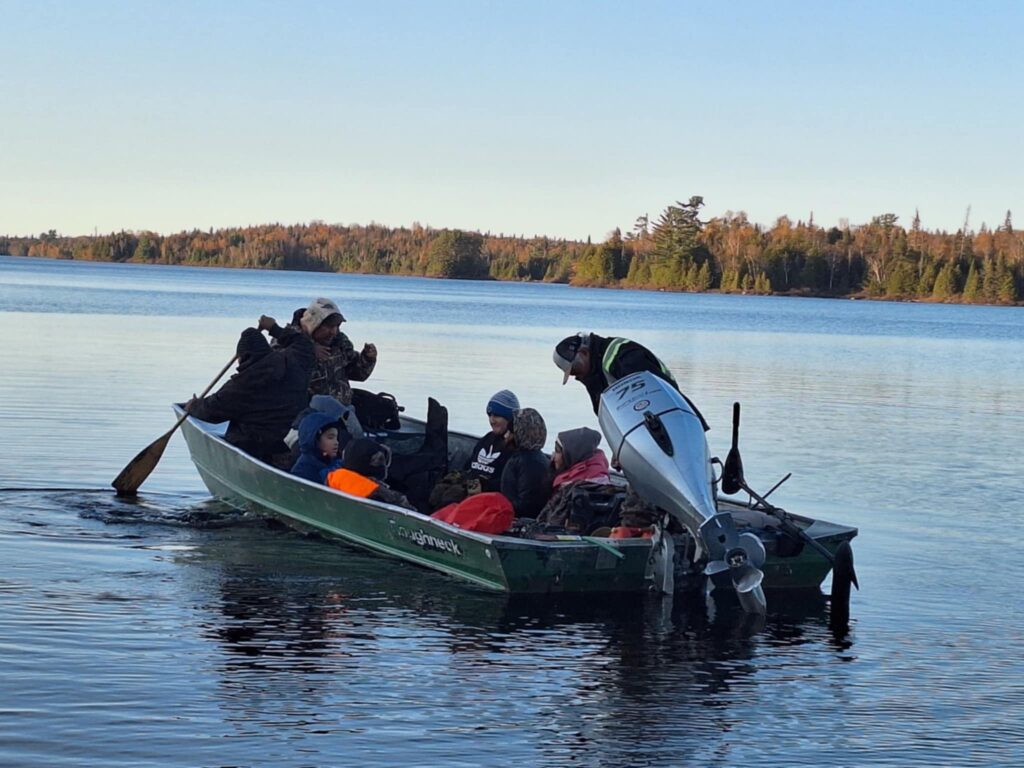
When the Anishnabe Moose Committee began our community-led research process, we were working with the idea of creating and implementing an Anishnabe Moose Management Plan, which would be shaped by what we heard from communities. The solutions brought forth by communities included better wildlife regulations and enforcement, leadership and education for the next generations, inclusion of Anishnabe laws, Elders gatherings, and whole-nation information sharing and decision-making. Additionally, a longer, five- to 10-year moratorium with a comprehensive study on the moose population is needed. These are elements of traditional governance that are explained in more detail below.
Collaborative management, or co-management, is not an acceptable solution for our people either, because of the ongoing legacy of distrust with provincial wildlife departments that have broken agreements with our nation in the past. Elders have shared with us stories of historical agreements with colonial governments. Again and again, the agreements which we made with them were violated. One recent example of these broken agreements specifically relates to the moose in La Vérendrye Wildlife Reserve, which is now the largest wildlife reserve in Quebec, with over 4,000 lakes and rivers and two huge hydro reservoirs. From the 1950s until the 1970s, La Vérendrye was a protected area. In 1964, the Quebec government began a pilot project. It was agreed with the community of Barriere Lake that this would be a five-year pilot project where they would open up the park for the hunting of moose. They said this would be for only five years. At the time of agreement, they agreed that non-Indigenous hunters would need to have an Anishnabe guide during their hunt. After five years, when the pilot project was supposed to end, Quebec changed its position.
They then said that they meant five years of hunting bulls, followed by five years of hunting females and five years of hunting calves, thereby extending this “pilot project” to a total of 15 years, which was not the agreement the community of Barriere Lake had agreed to in 1964. At this point, Quebec also started to increase tourism, bringing in wealthy Americans to hunt and fish on the territory. They established a presence in La Vérendrye. They established game wardens. During this time, they observed all the pine species, white birch, spruce, and poplar, and saw all the wealth within the park, including moose, foxes, rabbits, bears, partridges, beavers, wolves, walleye, northern pike, lake trout, bass, and sturgeon. By 1979, La Vérendrye became a Réserve Faunique (“Wildlife Reserve”), which removes protections from forestry and hunting. In the early 1980s, Anishnabe guides were used as fishing and hunting guides but that practice was dropped in the early 1990s. The original five-year pilot project agreement was violated. Clearly, Quebec had no intention of honoring that agreement and continuously encroached on La Vérendrye in the following decades without the consent of the Anishnabe people.
This was not the first agreement that was broken. During the time of the fur trade and wars between the English and French colonists, our People began to observe resources becoming depleted, as they began to dig for gold and cut various trees. It became abundantly clear that inherent to the colonial presence was the extraction of our resources and destruction of our lands, waters, and communities.
To address this, an agreement was made and ratified through the Hudson Bay wampum belt. Through this treaty, it was agreed that they would not harvest more than one kind of tree and could not dig more than three feet deep in the ground—as long as the sun shines, the rivers flow, the leaves fall, and the wind blows. That is what the agreement said. We knew such limits would be necessary. But they violated that treaty, generation after generation, time and time again. Government and industry have been voraciously extracting resources from our territories, taking from our communities and lands and harming the moose, and offering very little in return.

Kina Kitchi-ogima eja wejigedj acticj eja nagok aki-ni panama nisitagon adi awa eja minosek kija-wedokwagantcj mozag. Kan kidatagosonon minosodiwin e’ja pagejishiwatcj mozag acitcj keja mino-madizitcj kewin mozag mojag.
The living legacy of colonialism and its ongoing consequences for our territories and our communities must be understood and taken into account when we seek solutions for the declining moose population. If not, we will simply perpetuate the same unbalanced and unjust power dynamics of colonialism.
Mitchogozi odanakonagewin odimbabdon Anishnabe Inindamowin eja kijagabidag Od’aki | Colonial laws and policies disrupt our traditional ways of caring for the Land
In Anishnabe territory, we cared for the land through our family territory system, which allowed us to closely observe and monitor a large territory. Each family would share that knowledge with the rest of the nation during an annual gathering. These yearly gatherings are part of our traditional governance, where the state of the Land was discussed, and any needed changes were made through a consensus process. Colonial government assimilatory and genocidal laws and policies aimed to remove Indigenous Peoples from exercising our sovereign rights on the territory through the implementation of the reservation system, the Indian Act, and residential schools, among others.
The Band Council system is a colonial tool created through the Indian Act that usurps traditional governance systems and replaces them with an ineffective top-down administrative structure. It creates division and conflicts within our communities and is a barrier to making decisions as a nation. Our traditional Indigenous governance is foundational to caring for our territories as sovereign people, but it cannot thrive under current policies that function through the Indian Act governance system and outright ignore our sovereignty.
Industries like mining and forestry work through Indian Act structures to extract natural resources within our territories and drastically alter the quality of the whole landscape. In Ontario and Quebec, provincial ministries do not involve Indigenous nations regarding wildlife management decisions (other than those with modern treaties in northern Quebec).
Colonial laws and policies have disrupted our traditional governance and ways of caring for the Land. They do not honour nation-to-nation relationships, such as they were understood in the original treaties. The strength of our traditional governance is tied to the health of the Land. It is our responsibility as Anishnabeg to fulfill our role as caretakers of our territory.
Aki eja kwikitamigog kina kiga animegomin | Climate change affects us all
At the same time, we must acknowledge that moose populations are declining in other territories as well. In Manitoba there is a serious concern about the state of the moose population, and in Mi’kmaq territory (Cape Breton), there has been a severe moose decline. While we cannot speak to the specific causes of the declines in other territories, it is clear that climate change is a common threat. It must therefore be addressed collaboratively. We must renew respectful nation-to-nation relationships to effectively work through climate change solutions. To do so, we need to return to the sacred treaties that mean the most to First Nations people.
Oshi Nigansodewin kija ojitowig Aki eja Kwiktamigog nogom | Treaty renewal under climate change
The original sacred treaties, such as those created with wampum belts, honour traditional governance. While many of these agreements are ignored or forgotten by colonial governments, they are the only way to begin repairing the relationship and to build respectful nation-to-nation approaches. When these original treaties were made, the sovereignty of Indigenous nations—that is, the recognition of Indigenous rights to self-govern and manage our affairs and territory—was respected. Our responsibilities as caretakers of the Land were embedded within them. Treaties ensured peace: peace for the signatory nations, peace for the territory, peace for the Land and peace for all other-than-human beings.
Original treaties between Indigenous nations and European settlers were made when forests were healthy, moose were abundant, and the climate was stable. Even so, environmental clauses were incorporated into the treaties such as within the Hudson Bay wampum. The current climate crisis creates a new urgency for renewing these original sacred treaties to address our shared responsibilities to address climate change. Returning to the original intent of the treaties now would require us to incorporate specific climate change considerations and the specific industrial activities that contribute to climate change, like forestry and the extraction of non-renewable natural resources. True climate adaptation should guarantee Indigenous decision-making about Land use within our territories under our traditional governance systems.
These treaties were forgotten; the accountability toward the treaties and responsibilities were forgotten because they were not revisited, as they were supposed to have been, every two years. This process of accountability was called “polishing the chain”. If this accountability process is maintained, renewed treaties can hold the promise of reversing climate change.
The ultimate goal of treaty renewal is ensuring that seven generations from now will inherit healthy lands. Restoring traditional governance allows for more space for Indigenous rights, language, culture, and ceremony to flourish on the territory. This will lead to healthier moose populations and better climate solutions for all. If we can achieve peace with each other through renewed treaties, then we will have achieved true reconciliation.
Oshki Nigansodewin nogom ta minsidjiade Anishnabeg odinakinagewin keja mikimatcj Aki-Tcojojonam kija wedokwaganitcj. Tadagon mino ijitigewin kija mamikikadeg aki keja minomadizitcj acitcj kina Wabanog Anishnabeg oda shawindana aki onakinagewin. Anish adi keja majitayag bin?
Renewed treaties would restore Indigenous governance systems that allow for the nation-to-nation relationship that is required to find true climate policy solutions. Furthermore, unity within the Anishnabe (Algonquin) nation and other eastern Indigenous nations would strengthen climate action. We acknowledge that this is no small task. So, how do we get there?
Eshpin kijigabidameg nigansodewin, panama nitim Anishnabe eja kendik aki kida mamwisemagin | The first step toward treaty renewal: A community-led forum for knowledge sharing
The revitalization of treaties needs to be community-led, because it depends on the knowledge holders, where treaty is held by community. Elected leadership and colonial governments need to play a part as well, by providing space to have these discussions. Building and bridging understanding is paramount to start repairing the trust necessary for reconciliation and treaty renewal.
Kija tagog nisistemowin oja kina kabi-ijaweybig aki kag. Kina Wabinog Anishnabeg ta-mamwisewag kija tabajamog megis kikendamowin keja wabidameg ishkwag kaja be inakonigewag Anishnabeg weshkitcj (“Keko masigetcj Kizis, Keko nibish nitagog, Keko nodin eh tanoweg acitjc keko nibi pimidjwog”).
To build a common understanding of historical sacred treaties, we must create a sacred space for discussion and knowledge-sharing. We suggest a large multi-day forum, where the community members and knowledge holders of the eastern Indigenous nations gather. Each nation would have the opportunity to recite the treaties they hold, and the conditions under which they were first made (“as long as the sun shines, the wind blows, the waters flow, and the grass grows…”).
In this context, traditional governance takes up the most space; traditional leadership and governance come from Anishnabeg, it comes from the people, it is not a top-down approach. Elders and knowledge keepers must be given the appropriate recognition and respect regarding the knowledge they have of the environment and history and provide the spiritual guidance that is needed to restore our climate.
Elected leadership and colonial governments can take place as listeners and learners in this space. Giving the space to knowledge holders honours the community-led ways of traditional governance. This mark of respect is owed to communities. This would open dialogue between knowledge holders and elected leadership. It is an opportunity for knowledge holders and community members to voice their concerns, visions, and guidance. We expect that this knowledge sharing would need to take place over three days.
This would ground the gathering in ceremony with an understanding of the original intent of the treaties, which creates a greater awareness of how the environmental and social conditions have changed and must be taken into account in modern times.
Following this first period of knowledge-sharing, community members can decide their own path and follow their own protocols regarding treaty renewal. This also provides an opportunity for the elected leadership to be accountable to the wishes of their people. Together, each nation can build their own recommendations and solutions for treaty renewal under climate change. This forum is a first step, an opening, that allows us to build understanding before deciding on the next steps.
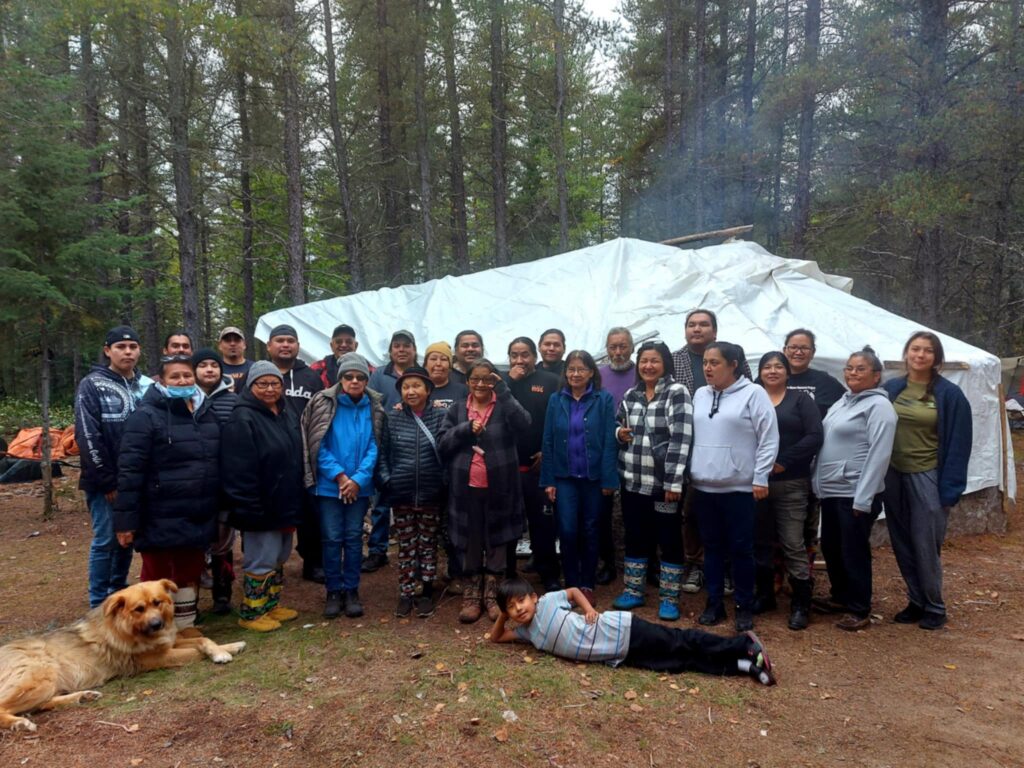
Crown governments can get involved in this process by facilitating the funding for this forum, attending and listening, and supporting the community-led treaty research and discussions that will take place before and after the forum. Community-based treaty research allows for communities to discuss treaties within their own nations before entering into discussions with others. In-community discussions will follow the forum, and it will be important to support that momentum and be accountable to each other and the knowledge learned during the forum.
Conclusion
This work started when Elders and Land users warned us about the moose decline. Protecting the moose led us to the bigger questions about how we all care for the land. Moose are our relatives that have taken care of us since time immemorial. Their decline is a warning that we must return to balance.
Treaty renewal must be transparent and inclusive. This means that everyone should have a voice, especially the people who live closest to the Land and see what’s really happening. We need to listen to the grassroots, to the ones who feel the changes in the water, the air, and the animals. We need to talk about responsibility to protect the land, the water, the animals, and each other.
Our communities have always known how to live in balance with the land. We carry that knowledge in our stories, in our ceremonies, and even in our dreams. The systems that hurt the land also hurt our communities. Logging, mining, and dams might create money, but they also destroy the homes of the animals and the health of our waters. These are not peaceful ways.
There is no peace in extraction, no peace in deforestation. These acts harm the animals and the people who have always lived in relation with them.
We know that energy and building homes are necessary, but we also know that change is needed. We must be willing to leave behind destructive ways and choose a new path that respects the Earth.
As Anishnabeg, we’ve faced colonization, language loss, and residential schools. These things disconnected us from who we are. But we’re still here. And we still carry the knowledge we need to rebuild. That’s what treaty is really about: returning to who we are, returning to our laws, our clan systems, our creation stories, and our responsibilities. Treaty is about restoring peace: peace for the land, peace for animals, and peace for our people. What we do now will shape what’s left for the next generations. We must choose wisely.
1 E.g. Manitoba and Cape Breton.
2 Anishnabe Moose Committee. November 2022. Anishnabe knowledge and governance for the protection of the moose populations in and around La Verendrye Park. Preliminary report from the Anishnabe Moose studies.
3 Inventaire aérien de l’orignal de la réserve faunique La Vérendrye réalisé à l’hiver 2020 Résumé des résultats. https://mffp.gouv.qc.ca/documents/faune/RA_inventaire_orignal_RFLV_hiver_2020.pdf
4 Honour’s thesis report led by Ken Downe. https://anishnabeanikiwin.wordpress.com/wp-content/uploads/2024/11/amc-newsletter-november-2024-2.pdf


